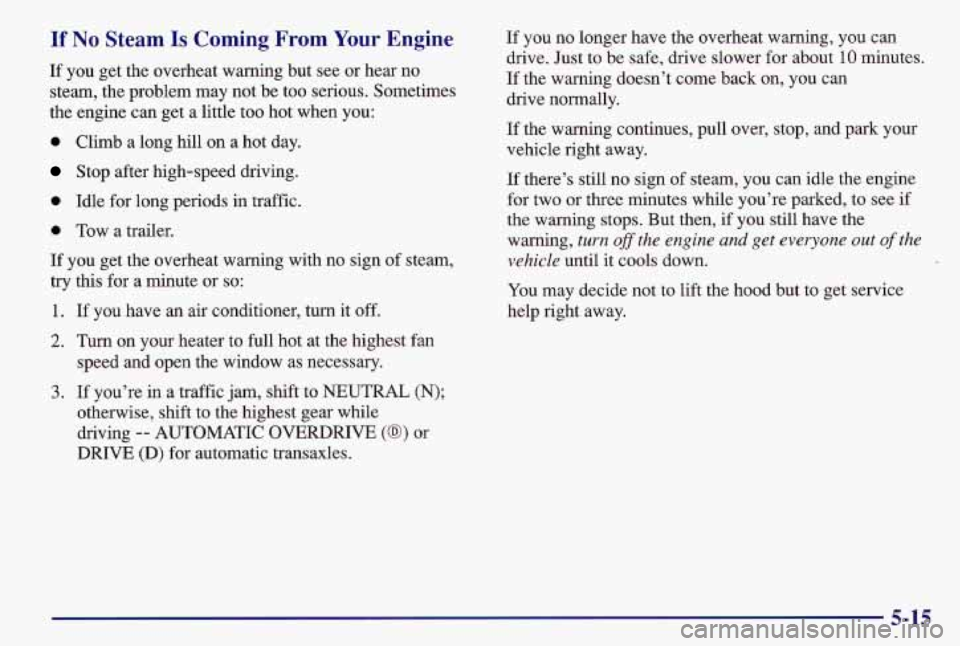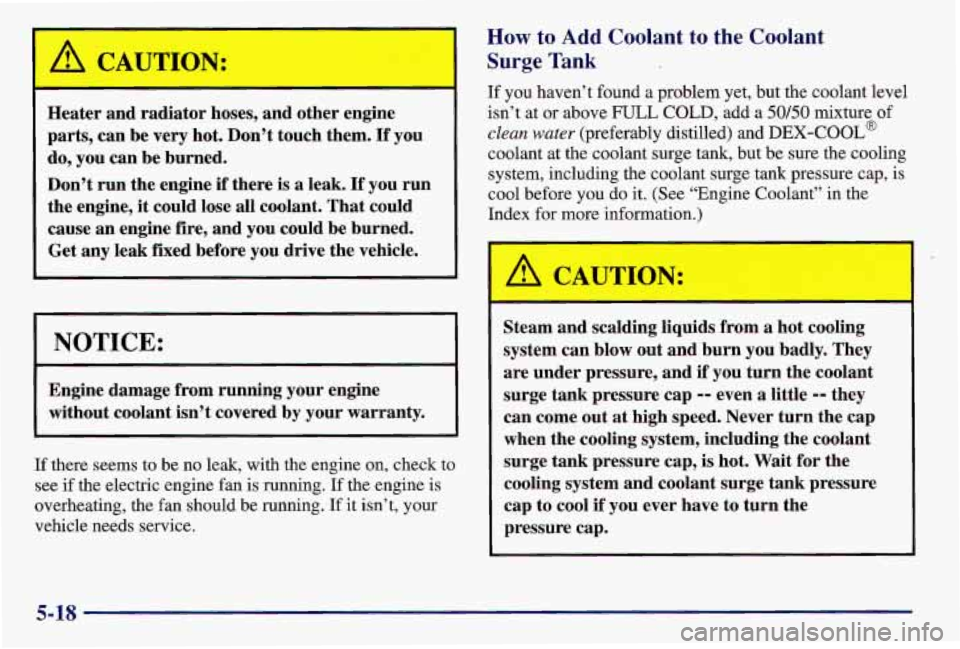Page 200 of 371
9. Attach the cable at least 18 inches (45 cm) away
from the dead battery, but not near engine parts that
move. The electrical connection is just as good
there, but the chance of sparks getting back to the
battery is much less.
the engine for a while.
10. Now start the vehicle with the good battery and run
11. Try to start the vehicle with the dead battery.
If it won’t start after a few tries, it probably
needs service.
12. Remove the cables in reverse order to prevent
electrical shorting. Take care that they don’t touch
each other or any other metal.
A. Heavy Metal Engine Part
B. Good Battery
C. Dead Battery
5-7
Page 207 of 371
Engine Overheating
You will find a coolant temperature gage and a low
coolant warning light on your Pontiac’s instrument
panel. See “Engine Coolant Temperature Gage”
and
“Low Coolant Warning Light” in the Index.
If Steam Is Coming From Your Engine
A CAUTION:
I
Steam from an overheated engine can burn you
badly, even if you just open the hood. Stay away
from the engine if you see or hear steam coming
from it. Just turn it off and get everyone away
from the vehicle until it cools down. Wait until
there is no sign of steam or coolant before
you
open the hood.
If you keep driving when your engine is
overheated, the liquids in it can catch fire.
You or
others could be badly burned. Stop your engine
if
it overheats, and get out of the vehicle until the
engine is cool.
NOTICE:
If your engine catches fire because you keep
driving with no coolant, your vehicle can be
badly damaged. The costly repairs would not be covered
by your warranty.
Page 208 of 371

If No Steam Is Coming From Your Engine
If you get the overheat warning but see or hear no
steam, the problem may not be too serious. Sometimes
the engine can get a little too hot when you:
0 Climb a long hill on a hot day.
Stop after high-speed driving.
0 Idle for long periods in traffic.
0 Tow a trailer.
If you get the overheat warning with no sign of steam,
try this for a minute or
so:
1. If you have an air conditioner, turn it off.
2. Turn on your heater to full hot at the highest fan
speed and open the window as necessary.
3. If you’re in a traffic jam, shift to NEUTRAL (N);
otherwise, shift to the highest gear while
driving
-- AUTOMATIC OVERDRIVE (@) or
DRIVE (D) for automatic transaxles.
If you no longer have the overheat warning, you can
drive. Just to be safe, drive slower for about
10 minutes.
If the warning doesn’t come back on, you can
drive normally.
If the warning continues, pull over, stop, and
park your
vehicle right away.
If there’s still no sign of steam, you can idle the engine
for two or three minutes while you’re parked, to see if
the warning stops. But then,
if you still have the
warning,
turn ofSthe engine and get everyone out of the
vehicle
until it cools down.
You may decide not to lift the hood but to get service
help right away.
5-15
Page 209 of 371
When you decide it’s safe to lift the hood, here’s what
you’ll see:
2.4L Engine
3100 Engine
A. Coolant Surge Tank With Pressure Cap
B. Electric Engine Fan
5-16
Page 210 of 371
/II CAUTION:
An electric fan under the hood can start up even
when the engine is not running and can injure
you. Keep hands, clothing and tools away from
any underhood electric fan.
If the coolant inside the coolant surge tank is boiling,
don’t do anything else until it cools down.
The coolant level should be at or above
FULL COLD.
If it isn’t, you may have a leak in the radiator hoses,
heater hoses, radiator, water pump or somewhere else in
the cooling system.
5-17
Page 211 of 371

/11 CAUTION:
I
Heater and radiator hoses, and other engine
parts, can be very hot. Don’t touch them.
If you
do, you can be burned.
Don% run the engine
if there is a leak. If you run
the engine,
it could lose all coolant. That could
cause an engine fire, and you could
be burned.
Get any leak fixed before you drive the vehicle.
I NOTICE:
.
Engine damage from running your engine
without coolant isn’t covered by your warranty.
If there seems to be no leak, with the engine on, check to
see if the electric engine fan is running. If the engine is
overheating, the fan should be running. If it isn’t, your
vehicle needs service.
How to Add Coolant to the Coolant
Surge Tank
If you haven’t found a problem yet, but the coolant level
isn’t at or above
FULL COLD, add a 50/50 mixture of
clean water (preferably distilled) and DEX-COOL@
coolant at the coolant surge tank, but be sure the cooling
system, including the coolant surge tank pressure cap,
is
cool before you do it. (See “Engine Coolant” in the
Index for more information.)
A CAUTION:
Steam and scalding lipuids from a hot cooling
system can blow out and burn you badly. They
are under pressure, and
if you turn the coolant
surge tank pressure cap
-- even a little -- they
can come out
at high speed. Never turn the cap
when the cooling system, including the coolant
surge tank pressure cap, is hot. Wait for the
cooling system and coolant surge tank pressure
cap to cool if you ever have to turn the
pressure cap.
5-18
Page 212 of 371
1 A CAUTION:
Adding only plain water to your cooling system
can be dangerous. Plain water, or some other
liquid like alcohol, can boil before the proper
coolant mix will. Your vehicle’s coolant warning
system is set for the proper coolant mix. With
plain water or the wrong mix, your engine could
get too hot but you wouldn’t get the overheat
warning. Your engine could catch fire and you or
others could be burned, Use
a 50/50 mix of clean
~ water and DEX-COOL@ coolant.
NOTICE:
r
In cold weather, water can freeze and crack the
engine, radiator, heater core and other parts,
So
use the recommended coolant. 1
5-19
Page 213 of 371
A CAUTION:
You can be burned if you spill coolant on hot
engine parts. Coolant contains ethylene
glycol
and it will burn if the engine parts are hot
enough. Don’t spill coolant on a hot engine.
1. You can remove the coolant surge tank pressure cap
when the cooling system, including the coolant surge
tank pressure cap and upper radiator hose, is no
longer hot. Turn the pressure cap slowly about
one-quarter turn to the left and then stop.
If you hear a hiss, wait for that to stop. A hiss means
there
is still some pressure left.
2. Then keep turning the pressure cap slowly, and
remove it.
5-20